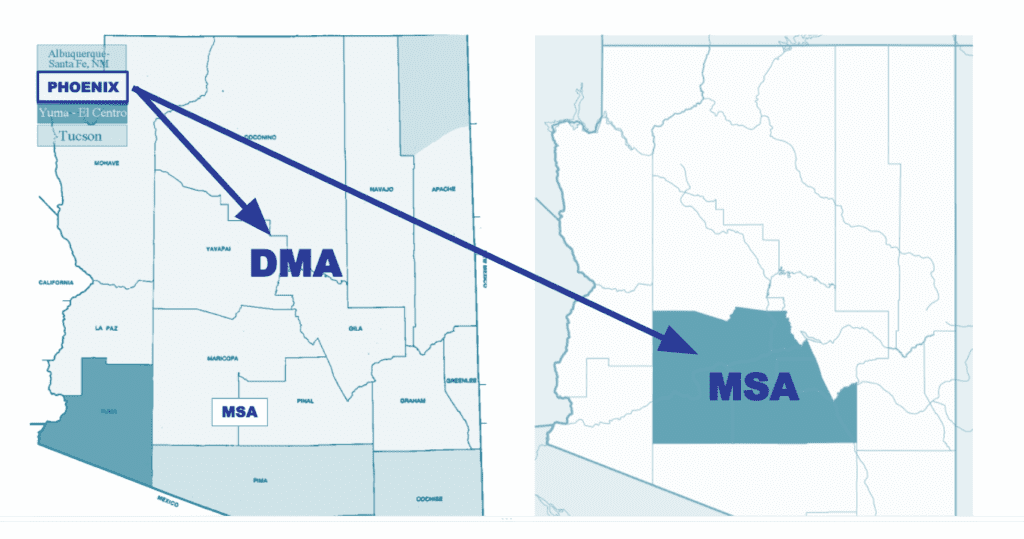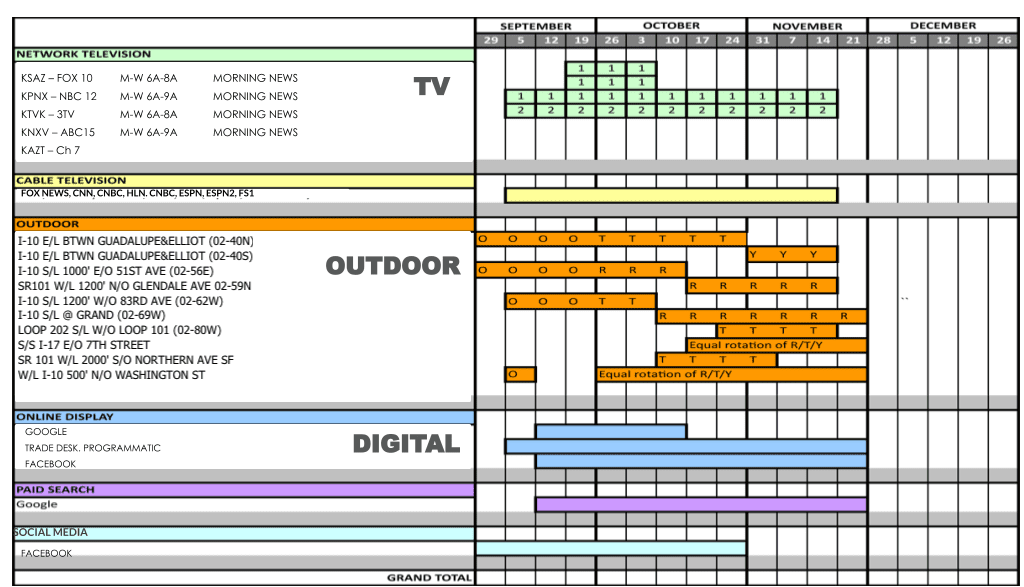The Ultimate Guide to Traditional Media Buying
Colling Media holds to the belief that traditional media is a vital part of any marketing campaign. We’ve written about it a lot: Don’t Cut Radio Advertising; Drive up Paid Search Performance, Top 10 Rules for Billboard Advertising, Is TV Advertising Still Effective, Relevant, and Worth It? After all, if traditional media were no longer getting results, large brands like McDonald’s, Walmart, and Amazon would not use them. Effective traditional media buying elevates brand recognition, assists in driving traffic to your website offer pages, and increases sales. Skilled traditional media buyers are an asset to any marketing team.
Defining Media Buying
Most ad agencies have traditional Media Buyers. The Traditional Buyers focus on Broadcast media with sales teams or media reps requiring media buy contracts. In contrast, Digital Buyers typically buy programmatically without needing a representative.
The traditional media buyers work broadcast advertising schedules complementing the overall marketing strategy. Because most go-to-market strategies involve conventional and digital channels, any decisions about ad placement should include conversations with digital team leaders. The role is to understand what media channels most efficiently reach the client’s target audience within an established budget.
The Traditional Buyers contact Media Reps to negotiate pricing and placement and execute a campaign. Digital Buyers use various self-service platforms to build and purchase their Digital campaigns.
Traditional Media Buying Terminology
A Request for Proposal (RFP) is an official document announcing and providing details about an upcoming media buy and solicits bids (or rates) from media venues. Media outlet sales reps typically review RFPs.
Added Value refers to extra or free inventory included in a broadcast buy to sweeten the Buyer’s deal. It is a surprisingly common practice used for maintaining a lower ad price point.
TIP: The added value should always be a part of a broadcast advertising RFP.
Insertion Order (IO) is a media buy order for an advertisement(s) for a broadcast station or other medium.
Traffic is the scheduling of advertisements for the broadcast day/week. There is a vital link between sales (of ads or commercial space) and traffic managers responsible for managing the flow of advertisements in their inventory in a commercial radio or TV station.
Media buyers or assistants are usually accountable for sending traffic to the media outlets purchased on the buy. Traffic is an official document and includes campaign details like the client, flight dates, spot rotation, and links to creative assets.
Impressions are the total number of views of your media – usually expressed in thousands (000).
DMA vs. MSA – DMA is a Nielsen TV measurement term for Designated Market Area and refers to where TV signals can reach to determine the area for each market. MSA is a Nielsen Audio Measurement term for Metropolitan Statistical Area and refers to how far radio signals reach in defined broadcast markets.

Dayparts are time segments days are divided by broadcast media.
General TV Dayparts are Morning News (M-F 6A-9A), Daytime (M-F 9A-3P), Early Fringe (M-F 3P-5P), Early News (5P-6:30P), Prime Access (M-F 6:30P-7P), Prime Time (7P-10P), Late News (10P-10:30P) and Late Fringe (10:30P-12A).
General Radio Dayparts are Morning Drive (M-F 6A-10A), Daytime (M-F 10A-3P), Afternoon Drive (M-F 3P-7P), and Prime (M-F 6A-7P).
Run of Schedule (ROS) usually refers to Total Day (5A-12M), where the advertiser or agency has not requested specific times and programs.
Logs are written records of broadcasting spot times. Two logs are available: PRE-LOGS for the upcoming week (what ads will run). POST-LOGS for the week prior (what ads ran).
Pre-Emption is the substitution of one advertiser’s ad by another advertiser, paying a higher rate for the same time and program.
Make-Goods happen if an ad unit is preempted, did not run, or ran incorrectly; it needs to be made-good with a comparable ad unit of equal or more excellent value.
Broadcast Calendar is a standardized calendar used to plan and purchase radio and television programs and advertising.
Traditional Media Buying Process
Evaluating Campaign Goal
- Brand awareness or Audience Education
- Increase phone calls, website visits, or foot traffic
- Immediate call to action for a sale, event, or service
Defining Target Audience
- Demographic (Ex: A25-54, HHI $75K+)
- Psychographic (Ex: People who go hiking at least 2x a month)
Consider Geography
- Media Markets
- Zones / Zip Codes
Factor in Timing & Seasonality
- Continuity vs. Flighting – Ex: chewing gum vs. snow tires
- Consistency in media behavior (Ex: Morning Routines vs. Evening Routines)
- Client’s Business Hours
Audience Research
Identify your Target Audience and their media habits to determine the best place to advertise (request Research). Have Media Reps pull Audience Research.
Demographics
- Age range: Adults 25-54, Adults 35-64, Adults 18-49
- Household Income: $75,000 plus per year
- Education: Earned College Degree or Higher
- Kids in Household: Have Children aged 2-11 yrs old
Behavioral
- New Home Buyers
- Exercise / Gym Enthusiasts
- Investors / 401K / IRAOutdoor Enthusiasts
- Home Improvers (DIY)
- New Car Buyers
- Use research to determine the media habits of the target group and support media recommendations.
The following media habits are available:
Television
- Number of days watched
- Types of programs watched
- Specialty channels watched
- Dayparts watched
- Avg. number of hours watched
Radio
- Number of days listened
- Station formats listened to
- Program types listened to
- Avg. number of hours listened
Outdoor
- How many miles drive per week
- Transit usage
Newspaper
- The number of issues read
- Section read
- Weekday versus weekend reading
Internet
- Hours per week
- Website categories accessed
- Online shopping habits
Traditional Mediums Strengths and Weaknesses
Television (Network, Cable, Satellite)
Strengths
- Broad reach
- Can target by demo or psychographic audience
- Buzzworthy programs
- Full DMA or national coverage
- Intrusive and immediate
- Sight sound and motion
- Strong branding capabilities
Weaknesses
- Declining ratings/ fragmented audience
- High out-of-pocket cost
- Seasonality
- High production cost
- Limited ability for geographic or micro-targeting
- Tune-out and DVR factors
Radio (AM, FM, Satellite)
Strengths
- Copy change flexibility
- High-frequency medium
- Live reads and sponsorships/ promotions and community tie-ins
- Low out-of-pocket pricing & production costs
- Mobility – in-car listening
Weaknesses
- Not a visual medium
- Difficult to build reach
- Highly cluttered
- Poor measurement
- The audience is not always actively engaged
- Declining listenership
Outdoor/Out of Home (Billboard, Bus board)
Strengths
- Broad Reach & High Freq
- Ability to target specific locations
- Strong impact
- Creative opportunities
- All-day, all-week exposure
- Low CPM
Weaknesses
- Short exposure time (6-8 seconds)
- Limited message capability
- Limited demo targeting
- Questionable measurement
- Susceptible to creative damage from weather or graffiti
- Higher production fees
Direct Mail
Strengths
- Targeting by location, personal interest, or buying habits
- Unlimited message length
- Coupon offerings
- (Relatively) Easy to track response
- Low CPM
Weaknesses
- Non-intrusive – thrown out, or unopened
- Typically low response rates
- Requires a strong mailing list
- Highly cluttered
- Production costs can be high depending on the size
- It can be considered Junk Mail
Print (Magazine, Newspaper)
Strengths
- Immediate reach
- Detail product explanation
- Geographic targeting
- Variety of ad sizes and executions
- Tangible- couponing, etc.
Weaknesses
- Shorter shelf life
- Declining circulation
- Skews older (50+)
- Sometime cluttered
- Can get expensive
How to Buy Traditional Media
Invite media outlets to pitch your business based on their reach or composition of the target audience. Consider channels not measured by syndicate research on the strength of the product.
Media channels should be evaluated and selected on their quantitative attributes:
- Cost / CPM (cost/impressions) x 1,000
- Reach / Frequency
- Environment
- Target involvement (time spent listening (TSL), affinity)
Negotiate Traditional Media Ad Rates
The basics of any negotiation are sellers come in high, the buyers come in low, and then there is usually a meeting in the middle. Never accept the high broadcast rate.
Seasoned traditional media buyers keep track of ad supply and demand, ad rate trends in the market, and where bonus inventory is clearing, as those rates can be lower.
Learn The Broadcast Calendar
The Broadcast Calendar conforms to uniform cycles for broadcasters, agencies, and advertisers for billing and planning functions. The standard broadcast week starts on Monday and ends on Sunday and every month has either four or five such weeks. The weeks also have designated numbers, which you see on the left of each week in blue. Scheduling broadcast campaigns happen by the week, and thus the weeks are referred to by numbers.
TIP: Strive to get results in one medium before adding other mediums or stations. Avoid fragmenting your efforts.
Reach vs. Frequency
Reach measures the unduplicated number of people exposed to an ad message
Frequency measures the number of ad exposures. Most ad agencies prefer one over the other for their media goals (i.e., maximizing reach or maximizing frequency) as advertising budgets usually do not allow advertisers to have both.
Ways to build frequency:
- Multiple insertions in the same medium, dayparts, and days
- Consistent schedule week to week, or month to month within any medium
- Tightened rotations and dayparts (i.e., Mon-Wed versus Mon-Fri, or 6a–8a versus 6a-9a)
- Running 15-sec spots vs. 30-sec ads
TIP: The more robust the message frequency, the quicker the response. The average consumer needs four exposures before a message registers with them. Studies show that after seven ad exposures, consumers are more likely to take action.
You can build frequency with consistency in media selection and creative messages. Focus on a specific geographic area and a few well-targeted media vehicles and dayparts for budgetary reasons.
Optimizing Traditional Media Buys
Retrieve Spot Times or Logs
Reviewing weekly spot time reports ensures your broadcast schedule is running (you would be amazed how many orders can fall through the cracks), spots and bonus spots are placed correctly, and your weekly budget is pacing to plan. Check for makegood opportunities and ensure equal or greater value for any media pre-empted or bumped by higher-paid ads.
Monitor Ad Placement
Ask for weekly spot times (PRE-LOGS and POST-LOGS) and ensure spots run as planned.
Invoice Reconciliation
Check for discrepancies and get these items cleared up ASAP to ensure accountability.
Confirm Added Value
Always monitor that the promised added value ads are also running and in the period/daypart promised (i.e., no overnights if promised M-F 6a-12mid).
Sample Media Plan

Conclusion
Successfully communicating marketing messages on all channels is essential for moving customers through the sales funnel, which is why Traditional Media should remain a crucial part of any company’s advertising mix. Reports of digital advertising budgets rising and TV, radio, and billboard media spending declining have been around as long as there have been digital channels to place ads. Most companies find out that multiple medium strategies get better advertising results because digital-only marketing campaigns often limit products and services’ maximum sales potential.
Gaining experience as a Traditional Media Buyer provides an essential view of marketing campaign success. Acquiring the skills and expertise needed to be a successful Traditional Media Buyer is typically learned on the job rather than in a classroom – which is why companies hire advertising agencies to handle matrix-style and fast-moving traditional media buys.
Looking for Traditional Media Buying Services? Contact us today.
You may also enjoy What is Over The Top Advertising and Why Your Business Should Be Using It?
